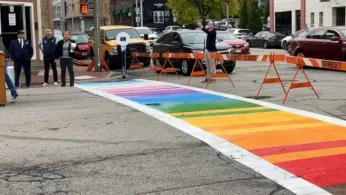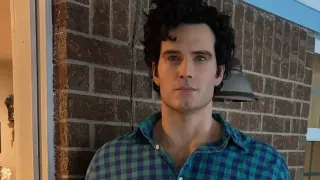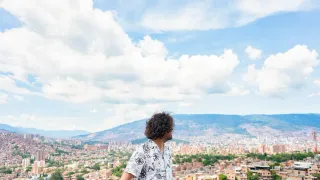
Oct 9
Milwaukee Unveils Pride-Themed Rainbow Crosswalks in Historic Walker’s Point
READ TIME: 3 MIN.
On October 6, 2025, the intersection of South Second Street and West National Avenue in Milwaukee’s Walker’s Point district was transformed by the installation of bold, rainbow-painted crosswalks—a new landmark in a neighborhood with over eight decades of LGBTQ+ history. The project, spearheaded by the Wisconsin LGBTQ History Project, marks both a celebration of LGBTQ+ identity and a pointed response to ongoing national campaigns seeking to eliminate such public displays of queer visibility .
At a dedication ceremony attended by more than 100 community members, local leaders, and allies, the street art was unveiled alongside stenciled koi fish, a signature motif by Wisconsin-born artist Jeremy Novy. The event was described as a “living, breathing archive on the streets of Milwaukee right beneath our feet” by organizers, underscoring the project’s significance as both a historical marker and a rallying point for ongoing advocacy .
Walker’s Point has long been recognized as a hub for the city’s LGBTQ+ community, with its roots dating back to the post-World War II era. In the 1940s and 1950s, the neighborhood’s taverns quietly signaled their openness to LGBTQ+ patrons by illuminating blue light bulbs above their doors—a subtle but powerful beacon at a time when open celebration was dangerous . Over the years, these “blue light” bars fostered one of the highest concentrations of gay-friendly spaces in the nation, shaping Walker’s Point into a vibrant nexus for LGBTQ+ life.
The newly installed rainbow crosswalks honor this legacy, offering a contemporary symbol of the neighborhood’s ongoing transformation. Today, Walker’s Point is a thriving district filled with restaurants, nightlife, and new residents, yet it retains its status as a sanctuary for LGBTQ+ people and allies .
The crosswalk project was made possible through a partnership between the Wisconsin LGBTQ History Project, the Milwaukee LGBT Community Center, local businesses, and recognized artist Jeremy Novy, who contributed his iconic koi fish stencils to the sidewalks . Funding was provided entirely by private donors, sponsors, and grants, coordinated through the Bring the Rainbows Home Fund, ensuring both installation and long-term maintenance without public expense .
Crowley Construction, a local firm, handled the painting, while ongoing upkeep will be managed by the History Project and neighborhood businesses. The crosswalks are intended not only as art but as a means of honoring “changemakers who’ve created safe spaces for the local LGBTQ community for more than eight decades,” according to project advisors .
The unveiling of the Walker’s Point crosswalks comes as rainbow street art and Pride installations face increasing scrutiny and removal in various U.S. cities, where conservative lawmakers and activists have mounted campaigns to restrict LGBTQ+ visibility in public spaces . Against this backdrop, local leaders have emphasized the urgency and impact of the Milwaukee project.
“For some people this is just a rainbow, for some people this is just a crosswalk,” said Michail Takach, chair of the Wisconsin LGBTQ History Project. “But the importance of this cannot be overstated right now” . The crosswalks, Takach and others noted, serve as a visible affirmation that LGBTQ+ people “are home” in Walker’s Point, regardless of the national climate.
Community advisor Bill Wardlow added, “They will send a message of safety and belonging to those who live here and those visiting from all over the world. They are a reminder that here in Walker’s Point, you are home” .
The October dedication was not merely a celebration of art, but a call to continued vigilance and advocacy. The intersection, now adorned with the full spectrum of the rainbow, stands as a testament to Milwaukee’s LGBTQ+ history and its ongoing fight for visibility and acceptance .
As communities across the United States grapple with questions of belonging and visibility, Milwaukee’s Walker’s Point offers a vibrant model of how public art can serve as both a memorial to past struggles and a beacon for future generations. The rainbow crosswalks invite all who pass by—residents, visitors, and allies—to reflect on the power of visibility, the value of safe spaces, and the enduring strength of a community united in pride.






